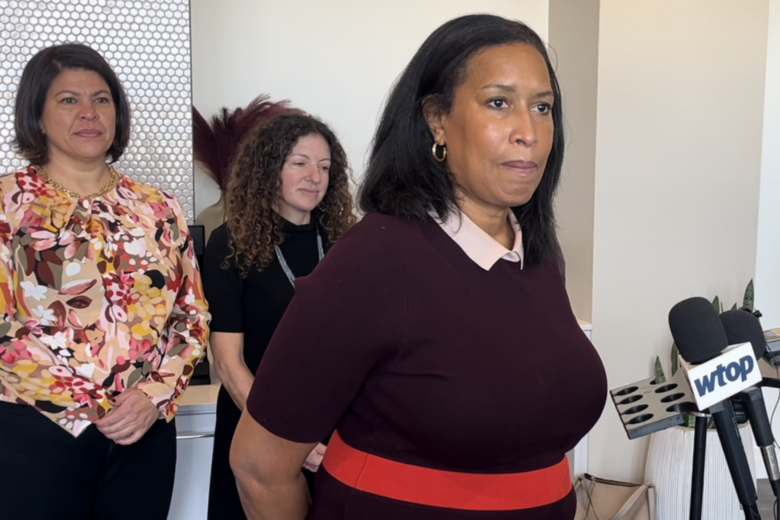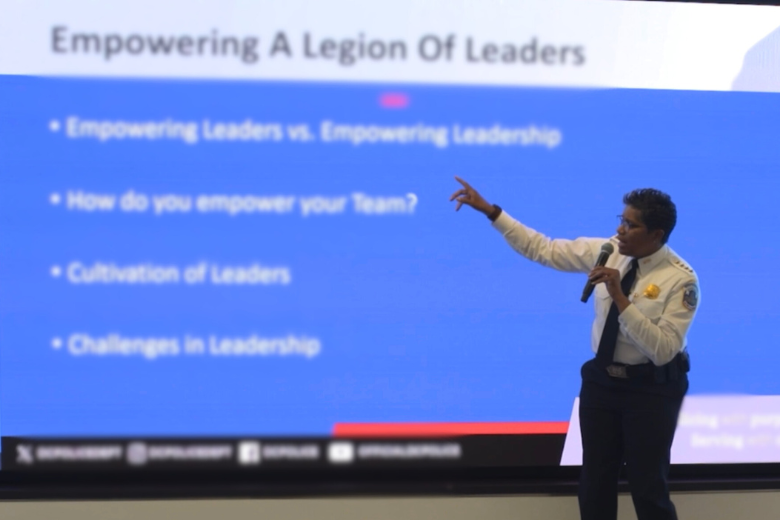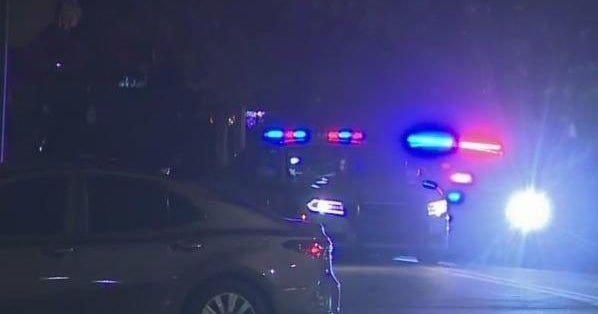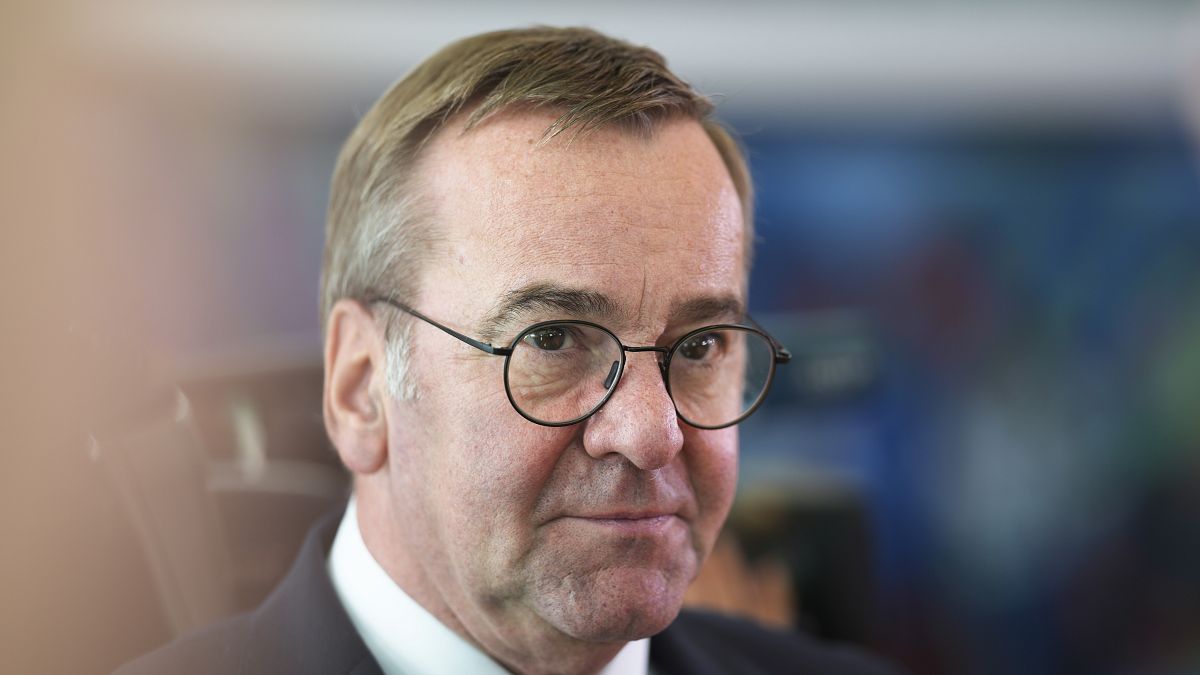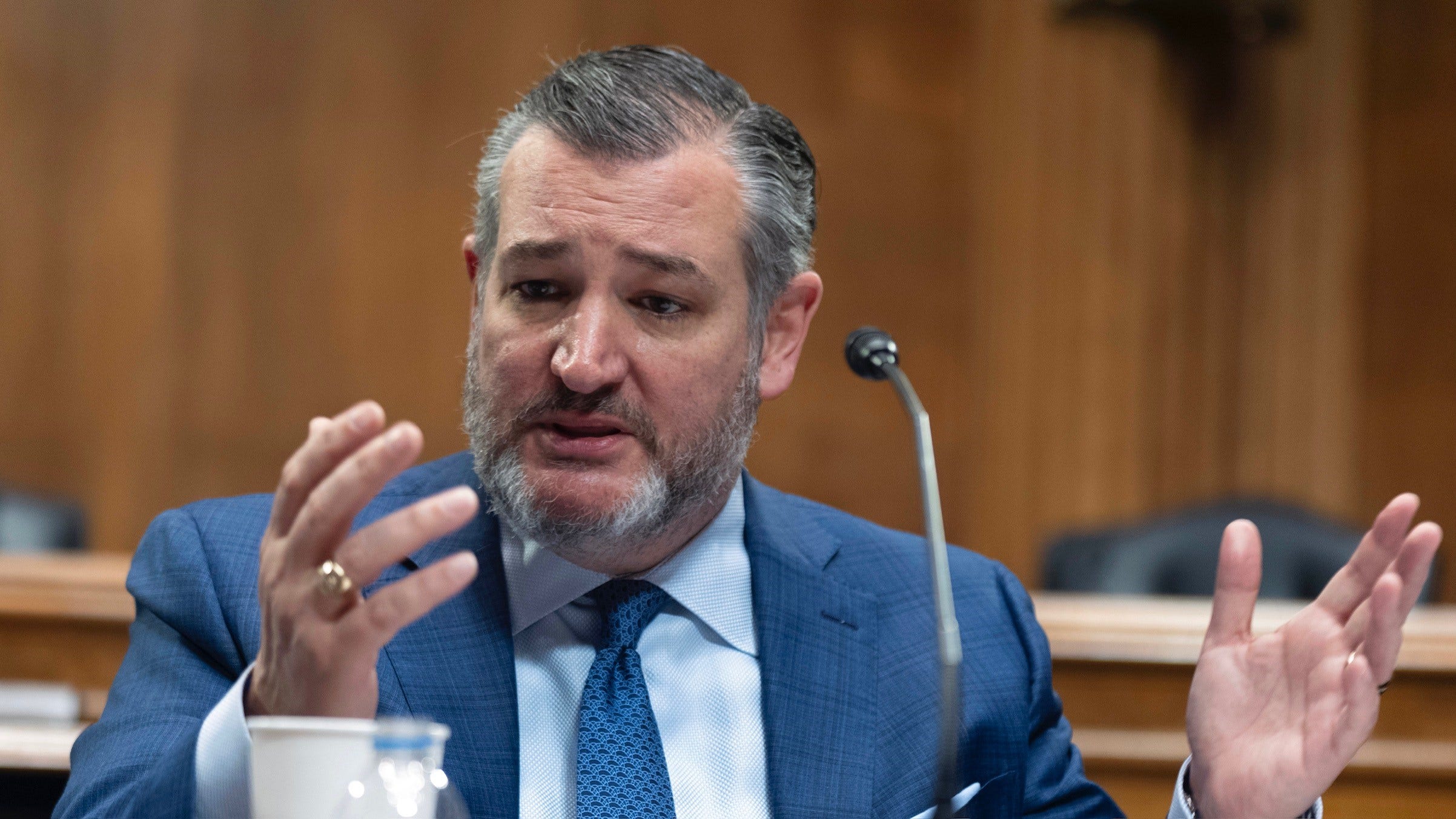Washington, D.C
U.S. Coast Guard Outperformed During Guam’s Mawar Recovery. Will Washington DC Notice?

Coast Guard C-130J makes first post-Mawar arrival at Anderson Air Force Base, Guam
While Guam struggles to recover from Typhoon Mawar, the U.S. Coast Guard has performed particularly well. Thanks to Coast Guard’s comprehensive pre-storm preparation and diligent post-storm recovery efforts, Guam’s port opened far faster than Guam’s disaster planners expected, helping the Port Authority of Guam return to normal operations. Will either the Administration or Congress notice?
While the Coast Guard’s superior performance in supporting Guam won’t make many headlines or excite much interest in Washington DC, it should. The U.S. Coast Guard’s deliberate investments in practical, low-profile capabilities, when coupled with the Coast Guard’s longstanding “bias for action”, is a perfect recipe for getting things done in a pinch. That effective approach deserves far more funding.
The Coast Guard merits a bigger slice of the Department of Homeland Security budget, as the scantly-funded and oft-overlooked organization has, once again, punched far above its weight, cementing a growing—and strategically important—role as an independent and trusted partner throughout the deep Pacific.
A still from a Coast Guard C-130 damage survey flight—taken while the tailing end of Mawar was still … [+]
How The Coast Guard Battled Typhoon Mawar:
The Coast Guard relied on three pillars to take on Typhoon Mawar. First, the organization recognized Guam’s meteorological and geographical challenges, making strategic—and relatively low cost—investments to position the Coast Guard for success in addressing a wide range of likely scenarios. Second, it relied on the organization’s bias—and freedom—for action, positioning assets early to address potential recovery challenges. And third, it got to work, completing disaster response missions an efficient, no-nonsense manner.
While the Coast Guard has known about Guam’s typhoon risks for decades, Typhoon-ready investments have been slow in coming. Only over the past three years, as the Coast Guard dispatched three new forward-deployed Fast Response Cutters to Guam, has the Coast Guard gotten funding to expand their typhoon-ready footprint on Guam. And those new Coast Guard base facilities, built to withstand life in “Typhoon Alley”, were immediately useful for local Coast Guard partners.
During Mawar, the Guam Fire Department relied on Coast Guard’s year-old Cmdr. Carlton S. Skinner Building. The strongly-built facility, constructed for the U.S. Coast Guard’s wide-ranging Maintenance and Weapons Augmentation teams, offered safe-haven for some of Guam’s mission-critical first-responder gear. In contrast, the main Coast Guard buildings on Guam, which the team has outgrown, date from the middle of the last century and upgrades or recapitalization efforts have been consistently pushed back due to operational Coast Guard commitments and limited construction funding.
To support Guam after Mawar, the Coast Guard team relied on their underappreciated organic air transport capabilities to move key personnel and critical gear into the region early. A Coast Guard HC-130J Hercules transport, with additional port assessment resources, left U.S. Coast Guard Air Station Barbers Point in Hawaii on May 24, and stood by on “nearby” Kwajalein, flying into Guam almost immediately after the typhoon passed, conducting assessment overflights.
A second Coast Guard HC-130J carrying repair and disaster assistance personnel arrived in the area shortly thereafter, and those planes were the first flights into both Guam’s hard-hit Andersen Air Force Base and the Antonio B. Won Pat International Airport. In total, the Coast Guard used three C-130’s in the response, offering quite a formidable capability demonstration from an agency that has only eight modern HC-130Js in the entire Pacific theatre.
On the ground, the Coast Guard didn’t wait. It prepared Guam’s port for heavy weather, and, within hours of the Typhoon’s passage, personnel from U.S. Coast Guard Forces Micronesia/Sector Guam and members of the Guam-based USCGC Sequoia (WLB 215) were in the field, assessing damage and making repairs. Coast Guard activities were publicly chronicled, presented in a stream of clear, detailed press releases.
Leaning into an active response paid off. Planning documents detailing Guam’s response to a catastrophic typhoon assume strong cyclones would close the island’s seaport—the heart of the island—for seven to ten days. Instead, the Coast Guard needed only about 72 hours, opening Guam’s port to military, commercial and cargo traffic on May 28.
Coast Guard cutters were the first vessels to enter Apra Harbor, and Coast Guard boats, crewed by Maritime Safety and Security Team Honolulu personnel who came in on a Coast Guard C-130, proudly escorted a Matson cargo ship carrying much-needed supplies to the stricken island.
The Service also leveraged their professional reputation and called on longstanding relationships with local Department of Defense elements to support reopening the port and clearing the facility. The U.S. Navy CTF-75 and their Explosive Ordnance Disposal Mobile Unit Five worked on surveying and clearing underwater challenges, the U.S. Naval Mobile Construction Battalion One Detachment Guam’s crane crew handled buoys at the pier, the U.S. Marines Aviation Logistics Squadron 16 handled debris removal and, of course, the the Marines took on the ceremonial flagpole raising at the Coast Guard facility.
In the midst of all the recovery work, Guam’s Coast Guard team even handled a quick VIP visit by the low-profile Coast Guard Commandant, Admiral Linda Fagan—a visit that quietly signaled just how important complex disaster recovery missions are to the Coast Guard.
A USCG Fast Response Cutter—another entrant in the Coast Guard’s Unfunded Priorities List is the … [+]
Will USCG Success Drive A Budget Boost?
For Federal agencies, efforts to support distant American territories is something of a thankless task. Territories like Guam lack strong, organic representation in Congress, and local disaster response efforts on U.S. territories are often compromised by long-standing inefficiencies, corruption or political challenges. But the Coast Guard doesn’t care about all that and took on the mission anyway.
It’s great to see. Unfortunately, many of the tools that made the Coast Guard so helpful during Guam’s recovery of Typhoon Mawar just aren’t getting funded. And that is a serious problem for strategically important outposts like Micronesia.
The typhoon demonstrated that the Coast Guard can make great use of their strategic investments in solid, storm-ready infrastructure. But, rather than race to fund additional storm-ready investments in Coast Guard’s remote, strategically important bases in the Pacific, the most recent Administration budget left the Coast guard wanting. The Coast Guard’s current Unfunded Priorities List includes a modest request for $200 million in Pacific-focused capital improvements—a congressional “ask” largely for cutter-oriented improvements that likely represents only a tiny fraction of the Coast Guard’s actual needs ashore.
At Guam, the Coast Guard’s freedom of action was on full display. While the deployment of much of America’s disaster-response assets and capabilities are informed by the host state or territory, the Coast Guard showed how it can, given the Service’s particular authorities, be proactive, moving resources around the globe with few bureaucratic constraints.
The Coast Guard’s response to Mawar highlighted the Coast Guard’s long-distance lift. With the Coast Guard maintaining a total fleet of 22 HC-130 Hercules transport aircraft in almost constant readiness, the Service is a vastly underappreciated contributor to government mobility.
Those Coast Guard airlifters did a lot. Coast Guard District 14, which oversees operations in Hawaii and across the Pacific Islands region, reported on Instagram that three aircraft, supported by 31 Coast Guard personnel out of Barbers Point, Hawaii, clocked 97.3 hours of flight time, transporting 396,231 pounds of cargo and 169 passengers. According to the Coast Guard, the team completed 19 “vital missions” across 33 sorties.
To contrast, the U.S. Air Force’s Air Base in Yokota, Japan, with some 14 C-130Js available, proudly announced it had shipped over 36,000 pounds of frozen and refrigerated perishable items some 1,500 miles to-and-from Guam. While the Coast Guard flew in from a far greater distance, dispatching their platforms from Hawaii, some 4,000 miles away, few in Washington have really unpacked and highlighted the Coast Guard’s strong performance in the air and on long-distance maritime patrols.
Rather than celebrate the Coast Guard’s long-range maritime patrol aircraft, the maritime service is regularly forced to beg for more aircraft. For at least the past three years, the Coast Guard used the Unfunded Priorities List to request $120-140 million to purchase a missionized HC-130J aircraft from Lockheed Martin
LMT
The Coast Guard deserves better treatment from the Administration, the Department of Homeland Security and Congress. Perhaps, if the organization was moved to become a part of an independent Maritime Administration, combining the U.S. Department of Transportation’s Maritime Administration, the Federal Maritime Commission, maritime elements of the National Oceanic and Atmospheric Administration and the National Science Foundation research fleet, the Coast Guard could be unleashed to see what their no-frills competence might contribute if the Coast Guard and the American civilian maritime was, for once, fully funded.

Washington, D.C
DC ranks as fourth worst city for package theft with $231M in losses, reports find

WASHINGTON (7News) — Security company SafeWise has just released its annual theft report, just in time for the busy holiday shopping season.
While porch piracy may be leveling out, numbers are still very high and in the District, there’s reason to be concerned. D.C. ranks fourth worst city in the country for package theft, with over $231 million in losses this year. The released report reveals insights into crime rates, local security trends, and how communities combat porch pirates.
Around 120 million packages were stolen throughout the U.S. in 2023; 92 million incidents were of package theft and 261,000 package theft incidents per day.
Porch pirates snatched $16 Billion in goods.
Security.org also released its report this week, which shows similar numbers.
Based on a survey of 11,000 adults in 50 states, the report also noted that one-quarter of American adults have had a package stolen, and 4%, 14 million people, suffered a theft within the last three months.
Now, as you start making online holiday orders, here are the 10 worst cities for package theft in 2024.
1. New York City, N.Y.
2. Philadelphia, Pa.
3. Chicago, Ill.
4. Washington, D.C.
5. Houston, Texas
6. Atlanta, Ga.
7. Charlotte, N.C.
8. Dallas-Fort Worth, Texas
9. Boston, Mass.
10. Cleveland, Ohio
The average value of each stolen parcel was $204, meaning nearly $3 billion in e-commerce merchandise was swiped over this past summer. The survey found that nine out of ten consumers shop online at least once per month, and half do so weekly. 42% of the population sometimes leaves their doors unlocked, while around 15% do so even when they are not home. Such negligence makes their homes easy targets for burglars and increases the chances of package theft.
“We estimate that there are about 213 package theft incidents per 100 households in the D.C. area. That could represent nearly 500 out of a thousand people actually being impacted by this. So we know that it’s happening, we are definitely shopping online. I don’t want to tell people to stop shopping online, I myself am an avid online shopper, just take some proactive measures,” said Rebecca Edwards, safety expert at SafeWise.
READ| 1 in 4 people say they’ll go into debt for the holidays. Is social media to blame?
One of the biggest changes these reports have found is that more people are taking action to prevent package theft. Consumers are getting smarter. Nationwide, just one in four people don’t do anything to deter porch pirates. Those numbers change drastically after someone loses a package — more than eight in 10 added a deterrent after falling victim. Security.org’s survey shows that 52% of all households — renters and homeowners — have a security camera, compared to 42% in 2023.
Proactive Steps To Avoid Porch Piracy:
- Don’t leave packages unattended.
- Ship to store, storefront, or post office box.
- Require a signature.
- Opt-in to shipping-related emails. Set up your own notifications with your smartphone or app
- Make alternative arrangements. If you can’t be home to bring in those packages, have them delivered somewhere else. You can use a package locker service, ask a friend or neighbor, use a personal delivery locker on your porch.
SafeWise took a closer look at how people are fighting package theft. One in four Americans don’t do anything to protect their packages. Over eight in ten added some type of protection after being hit by porch pirates.
Of those who use a deterrent, 21% had a security camera or video doorbell in place when their packages were stolen. 32% said they installed a security camera after a package theft.
READ| How 2025 spending bill could affect taxpayers
“I have a package locker that sits on my porch that I have personally but I’ve also lived in apartments or in cities where Amazon lockers and things like that are available. So, take the extra time. This one little step is going to save you so much headache, money, and stress especially if a special Christmas present gets taken, it messes up your whole holiday plan,” added Edwards.
Ring was the most-purchased brand of security camera (46%). Package tracking and working with neighbors are the most used deterrents after cameras. People prefer to pick up prescription drugs, food and groceries, and computers and other electronics in person, rather than risk a package theft.
Package theft by the numbers:
Around 120.5 million packages were stolen in 2023.
Nearly 92 million incidents of package theft occurred in 2023. The US sees 261,000 incidents of package theft every day. 43 of the 327 metro areas had more than 1,000 incidents per 1,000 households. 8 in 10 victims had more than one package stolen in the past 12 months.
Amazon delivered the majority of packages stolen.
Washington, D.C
Trump Impact: DC mayor would ‘absolutely’ share ideas with Musk’s government efficiency task force – WTOP News
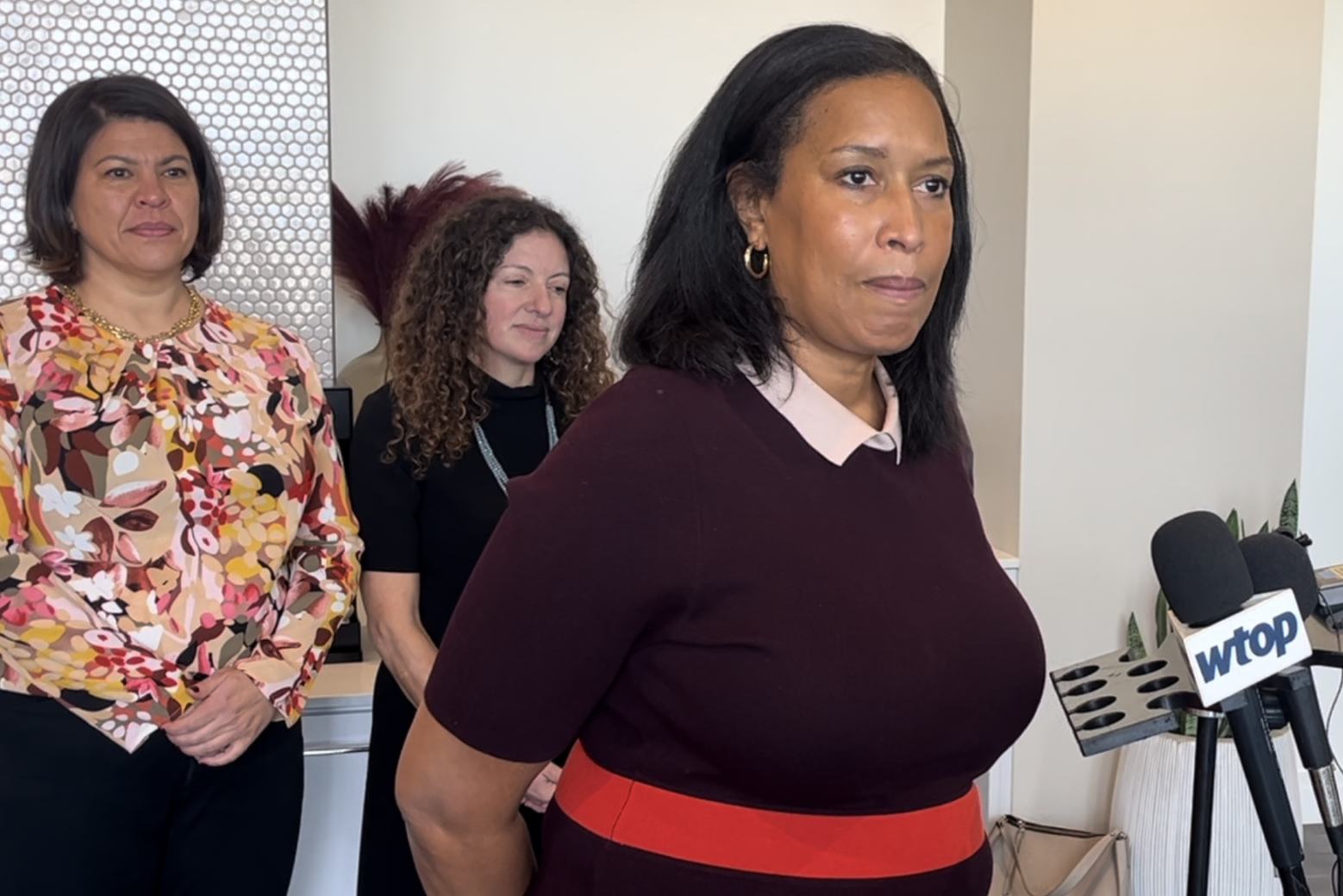
There seems to be some common ground between D.C. Mayor Muriel Bowser and Elon Musk, who will head a task force that will make recommendations to President-elect Donald Trump on how to reshape the federal workforce.
This story is part of WTOP’s ongoing series, Trump Impact, which looks at how the new administration could change the D.C. region.
The D.C. region will be hearing more and more about the world’s richest man, Elon Musk, in the coming months as he leads a task force that will make recommendations to President-elect Donald Trump on how to reshape the federal workforce.
At least in some areas, Musk and D.C. Mayor Muriel Bowser seem to agree.
Musk will lead a task force called the Department of Government Efficiency alongside Vivek Ramaswamy. The group posted a statement on social media late Wednesday saying federal agencies are using, on average, just 12% of the space in their D.C. headquarters.
“Why are American taxpayer dollars being spent to maintain empty buildings?” the statement asked.
More Trump Impact
When asked whether Bowser had any advice for the group related to that topic, the D.C. mayor said, “We think the federal government needs a centralized remote work policy.”
“Our message about that is the same as it’s been for the last almost four years,” Bowser said. “We think that government workers should be in their offices more than they’re on telework.”
When asked whether Bowser would be willing to work with the task force if it reached out to her, she responded by saying, “I absolutely will share my ideas.”
Plans for the Department of Government Efficiency are still coming into focus.
The group put out a call for “small-government revolutionaries willing to work 80+ hours per week on unglamorous cost-cutting.”
Applicants are encouraged to submit their resumes through X, the social media company that Musk owns.
In an opinion piece in The Wall Street Journal, Musk and Ramaswamy said that they want to “identify the minimum number of employees required at an agency for it to perform its constitutionally permissible and statutorily mandated functions,” leading to “mass head-count reductions across the federal bureaucracy.”
Some employees could choose “voluntary severance payments to facilitate a graceful exit,” the pair wrote.
Others would be encouraged to quit by mandating that they show up at the office five days a week, ending the pandemic-era flexibility that remote work provides.
The requirement “would result in a wave of voluntary terminations that we welcome,” Musk and Ramaswamy said.
The Associated Press contributed to this report.
Get breaking news and daily headlines delivered to your email inbox by signing up here.
© 2024 WTOP. All Rights Reserved. This website is not intended for users located within the European Economic Area.
Washington, D.C
DC police program trains upcoming leaders from around the country – WTOP News
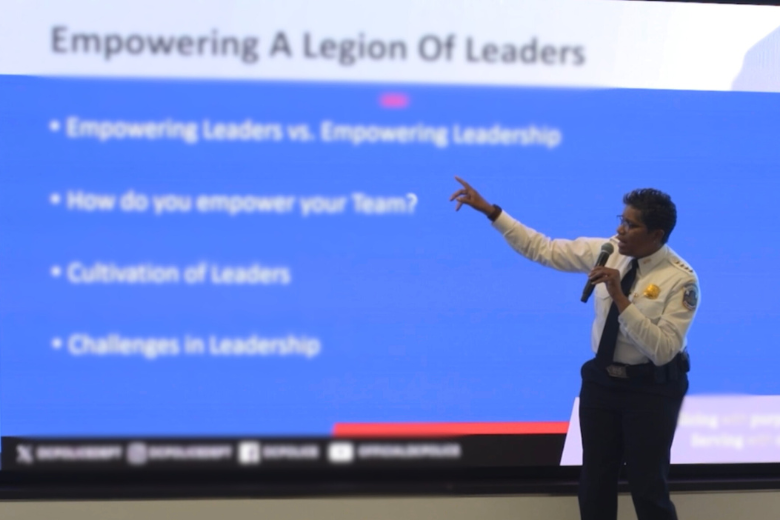
Dozens of law enforcement officials from across the country gathered Wednesday at the Australian Embassy in Northwest D.C. to discuss strategies for strengthening partnerships with international police agencies.
Dozens of law enforcement officials from across the country gathered Wednesday at the Australian Embassy in Northwest D.C. to discuss strategies for strengthening partnerships with international police agencies.
It was part of the D.C. Police Leadership Academy, a program designed to develop law enforcement leaders.
“This program targets … mid-level ranks, which is typically lieutenant or captain,” said Jessica Bress, the director of the D.C. Police Department’s strategic projects office.
The department first started the program in early 2023.
It’s about three weeks long and includes seminars from law enforcement experts.
The latest class, which is set to graduate on Friday, has more than 70 people in it, including 19 from the D.C. police force. All the others are from various departments nationwide.
Bress said people generally join the program to “learn leadership skills, network and meet a group of like-minded colleagues from across the country.”
“The problems that we’re dealing with in policing and law enforcement in America are sometimes the same everywhere,” said Bress. “There are also some differences, and there’s always benefits from learning and getting exposure to agencies outside of our own.”
John Fitzgerald, a lieutenant detective with the Boston Police Department in Massachusetts, is among those graduating this week.
“I’m learning a lot from working with people from state, local, federal and international law enforcement,” said Fitzgerald. “What I’m getting from it is perspective on how other places do it.”
Fitzgerald said the program has focused on technology, evidence-based policing and teaching people how to lead by example.
“It’s leaders wanting to lead,” Fitzgerald said. “Everybody who’s here has asked to be here or … worked really hard to get a slot here, and that means a lot.”
According to Bress, Wednesday’s visit to the Australian Embassy demonstrated the importance of building relationships with international law enforcement agencies.
“In D.C., we have more exposure to it, but these are participants from across the country,” said Bress. “A lot of them probably aren’t even aware of these international liaison networks.”
Get breaking news and daily headlines delivered to your email inbox by signing up here.
© 2024 WTOP. All Rights Reserved. This website is not intended for users located within the European Economic Area.
-
Business1 week ago
Column: OpenAI just scored a huge victory in a copyright case … or did it?
-

 Health1 week ago
Health1 week agoBird flu leaves teen in critical condition after country's first reported case
-

 Business5 days ago
Business5 days agoColumn: Molly White's message for journalists going freelance — be ready for the pitfalls
-
World1 week ago
Sarah Palin, NY Times Have Explored Settlement, as Judge Sets Defamation Retrial
-

 Politics4 days ago
Politics4 days agoTrump taps FCC member Brendan Carr to lead agency: 'Warrior for Free Speech'
-

 Science2 days ago
Science2 days agoTrump nominates Dr. Oz to head Medicare and Medicaid and help take on 'illness industrial complex'
-
/cdn.vox-cdn.com/uploads/chorus_asset/file/25739950/247386_Elon_Musk_Open_AI_CVirginia.jpg)
/cdn.vox-cdn.com/uploads/chorus_asset/file/25739950/247386_Elon_Musk_Open_AI_CVirginia.jpg) Technology4 days ago
Technology4 days agoInside Elon Musk’s messy breakup with OpenAI
-

 Lifestyle5 days ago
Lifestyle5 days agoSome in the U.S. farm industry are alarmed by Trump's embrace of RFK Jr. and tariffs






